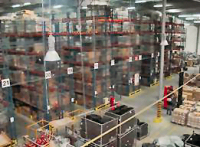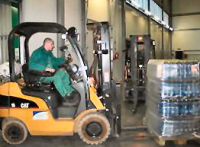 Modern central warehouses are complex units that are difficult to assess and consequently, also difficult to optimise.
Modern central warehouses are complex units that are difficult to assess and consequently, also difficult to optimise.
One of Europes leading warehouse experts, Dutch professor Ren de Koster, reveals a quick and easy method of delivering a qualified assessment of the warehouses form curve, based on a visual inspection and a survey.
More and more production is being located in Eastern Europe and Asia whilst consumption in Western Europe is only going one way, and that is up. This development puts pressure on companies' distribution and warehouse management functions, and many companies are attempting to deal with this pressure by establishing fewer, but very large central warehouses covering wider areas. Managing these warehouses is a huge and complex challenge, so that the warehouses deliver the right levels of efficiency and service at the right cost. Therefore, there is an increasing need for tools for assessing and comparing the performance of warehouses.
"Assessing a warehouses level of performance is a tricky business. Over time, I have visited countless warehouses, and it is still difficult for me to visit a warehouse and assess whether it is first class, average or is performing badly", says Ren de Koster before continuing: "However, it is actually possible for the trained eye to uncover a mass of information and details about the warehouses form curve, even with a quick tour around it".
Get an assessment in a few hours
For this purpose, Ren de Koster has developed a simple and quick method of assessment, whereby a form is completed immediately after a warehouse visit. Using this method only takes a few hours, and you do not need to possess an in-depth knowledge of warehouse management. The assessment is based on what you see along the way and responding to a number of questions immediately after the inspection. There is no need for complex IT calculations, advanced data mining or expensive consultants here, the task can be completed with a pair of observant eyes and a pen and paper.
The method involves marking a total of 11 aspects of the warehouse on a scale consisting of 6 steps. The marking scale goes from poor (1) to excellent (9), with an extra category "Best in class" (11) meaning that the warehouses performance cannot be bettered. The intermediate marking steps are 3, 5 and 7.
11 aspects of the warehouse
The eleven areas encompass:
- Customer satisfaction
- Cleanliness, environment, ergonomics, safety and hygiene
- Use of space, condition of the building and technical installations
- Condition and technical level of equipment for handling materials
- Cooperation, management and motivation
- Storage methods and strategies
- Order plucking methods and strategies
- Supply Chain coordination
- Level and use of IT
- Attitude to quality
- Handling of efficiency and flexibility as a function of volume, range and variety
 Ren de Koster has prepared a short introduction to each area, which the person or persons carrying out the assessment, familiarises him/herself with or is familiarised with prior to the inspection, so that they have a few guidelines to follow. Ren de Koster emphasises that the introductions are not at all advanced and are just a case of using "common warehouse sense".
Ren de Koster has prepared a short introduction to each area, which the person or persons carrying out the assessment, familiarises him/herself with or is familiarised with prior to the inspection, so that they have a few guidelines to follow. Ren de Koster emphasises that the introductions are not at all advanced and are just a case of using "common warehouse sense".
Tested the method
"We have tested the method on various groups of managers and students, 96 people in all, some of whom have experience of warehouse management and some who do not, from 22 different countries. The result shows a clear division between warehouses that score highly and those that score low in the assessment. The low scoring warehouses almost always get a "no" in question 21 of the survey "Would you like to work at this warehouse?" Conversely, in almost all cases, warehouses with a high score get a "yes" in question 21", Ren de Koster tells us.
Ren de Koster has validated the method using three validation methods, and he has concluded that the method is completely consistent with alternative but more demanding methods of assessment. Thus, it can be safely said that the method is pretty precise. However, he stresses that statistical material is still limited and that could give rise to some reservations. Naturally, the advantage is that in terms of time, resources and competences, it is easy to carry out an assessment using this method.
"After every warehouse assessment, we have confronted the warehouse manager with the results of the assessment and, in every case, he or she has declared that they agree with the assessment. The warehouse management are, of course, often aware of the weak points of the warehouse, but it is not always easy to change things. A poor layout for example, is difficult and expensive to rectify since it requires modification of buildings", says Ren de Koster.
A quick route to qualified knowledge
Ren de Koster views the method as a quick way of obtaining an assessment of a warehouses weak and strong points and as a supplement to more quantitative methods of assessment, such as financial analyses.
"It is my belief that if a warehouse scores highly on the basis of the visual inspection and survey, then yes, it is a well functioning warehouse. If it scores poorly, there is potential for optimisation, especially in those areas in which it scores lowest" , declares Ren de Koster.
Questionnaire
The total number of yeses on this questionnaire is an indicator of the warehouses overall performance. The more yeses, the better the performance. A question should be answered a yes only, if the warehouse obviously adheres to the principle implied by the question. In case of doubt, answer no.

About Ren de Koster
 Ren (M.) B.M. de Koster is professor of Logistics and Operations Management at RSM Erasmus University , Rotterdam . He formerly worked as a consultant in designing and implement ting logistic information and material handling systems. His research interests are warehousing, material handling, supply chain management, and retail logistics. He is (co-) author / editor of 8 books and over 100 papers in books and journals. He is a member of the ELA R&D committee and member of editorial review boards of 5 journals.
Ren (M.) B.M. de Koster is professor of Logistics and Operations Management at RSM Erasmus University , Rotterdam . He formerly worked as a consultant in designing and implement ting logistic information and material handling systems. His research interests are warehousing, material handling, supply chain management, and retail logistics. He is (co-) author / editor of 8 books and over 100 papers in books and journals. He is a member of the ELA R&D committee and member of editorial review boards of 5 journals.

Add a Comment
No messages on this article yet